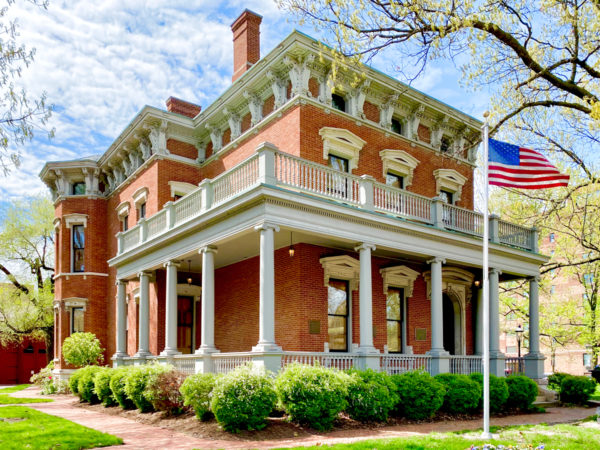Q&A with Charlie Hyde, President and CEO of the Benjamin Harrison Presidential Site
Published May 31, 2022

Your Old Glory, New Vision campaign is in full swing, and will renovate and transform the Benjamin Harrison Presidential Site. Can you give us an overview of the campaign and its goals?
Charlie: The $6M+ transformative capital campaign is the Presidential Site’s first, and was envisioned from the outset to do two things: 1) invest in preserving and enhancing the National Historic Landmark home of the 23rd president of the United States for the century ahead and 2) create a stunning gateway public space open to all that helps amplify our mission to encourage public participation in the American system of self-government. With over 30,000 annual visitors, many Hoosiers are already aware of this national treasure nestled in the heart of the city, but we see an opportunity to build upon our local relevance and national significance as the home of an American president and become recognized as a world class destination. That we’ve continued our climb into the top five “Things to Do” in Indianapolis on TripAdvisor user rankings suggests we’re making great progress—and more exciting plans are yet to come!
How do you envision the Old Glory, New Vision campaign will increase accessibility and inspire more Indianapolis neighbors and residents to visit the grounds and home of Indiana’s only U.S President?
Charlie: With the intersection of I-65 and I-70 on our doorstep, the Benjamin Harrison Presidential Site is at the crossroads of the crossroads—literally and figuratively. Our staff and board of directors have been very intentional. Between the capital campaign’s multi-million dollar investments and our vision to be “the most innovative, inclusive, and civically engaged presidential site in the country,” I think you’ll see this work manifest itself in the coming years in some important ways. One example is the new Neighborway, which will restore east/west pedestrian and bicyclist connectivity to the neighborhood lost through the depredations of interstate construction 50 years ago. This is important for quality of life of the many residents of the Old Northside and adjacent neighborhoods, and will most directly serve our immediate neighbors in apartments and low-income housing. We’re also excited about the ways in which these improvements will enhance our grounds for Indy through signature partnerships—with the Federal Court for Naturalization Ceremonies and Marion County Election Board as a Voting Center—along with new programs and initiatives, like the Juneteenth Foodways Festival and Future Presidents of America.
You mentioned that you host 30,000 visitors (17,500 of whom are children) each year. What seems to be the favorite part of the tour for your visitors?
Charlie: Apart from the marvelous folk art on the Centennial Cane—or Harrison’s name written in diamonds on the back of the gaudy Horn Chair, given as an inaugural gift—it has to be the overall quality of the personalized tour experience. As a privately operated non-political and non-partisan organization that receives no public funding for operations, we’re uniquely positioned to help share the story of America’s Hoosier President. And we’re able to do so in a way that is relevant to conversations we’re having today, from our rights and responsibilities as citizens, advocacy of Black civil rights, and protecting our natural resources. To be able to step into the home of an American president, and to be deeply immersed in that history—with 75-80% of artifacts on display in the museum original to the Harrisons themselves—is truly extraordinary. But to be able to draw even more deeply on the nationally-significant collection of over 10,000 artifacts is what makes our Presidential Site exceptional—it reveals the life and legacy of a President at a very human scale. As Benjamin Harrison said, “those who would associate their names with events that shall outlive a century can only do so by high consecration to duty. Self-seeking has no public observance or anniversary.”
I love what you shared about President Benjamin Harrison and the history of “No Mean City.” Please share with everyone the origins of that phrase that has come to describe Indy.
Charlie: President Benjamin Harrison was known by his contemporaries as an exceptional extemporaneous speaker, and it was in a landmark speech he gave to the Chamber of Commerce after his presidency in which he famously described Indianapolis as “no mean city,” suggesting that when compared to its peers nationally it excelled in many notable ways. He continued by saying, “But the ideal city must have other excellences. It must be a city where people diligently mind their own business and the public business, and do both with a decent regard to the judgment and rights of other men; a city where there is no boss rule in anything; where all men are not brought to the measure of one man’s mind or to the heel of one man’s will; a city whose citizens are brave and true and generous, and who care for their own…where brains and manners, and not bank balances, give ratings to men; where there is neither flaunting wealth nor envious poverty; where life is comfortable and toil honorable; where municipal reformers are not hysterical, but have the habit of keeping cool; where the broad judgment of a capital, and not the narrowness of the province, prevails; where the commerce in goods is great, but not greater than the exchanges of thought and of neighborly kindness. We have not realized all these things. We count not ourselves to have attained, but we follow after.”
But as admirable as these sentiments are, I prefer his words to friends and neighbors and thousands of well-wishers as he departed Indy for his inauguration as the 23rd President of the United States. He said simply, “I love this city.”